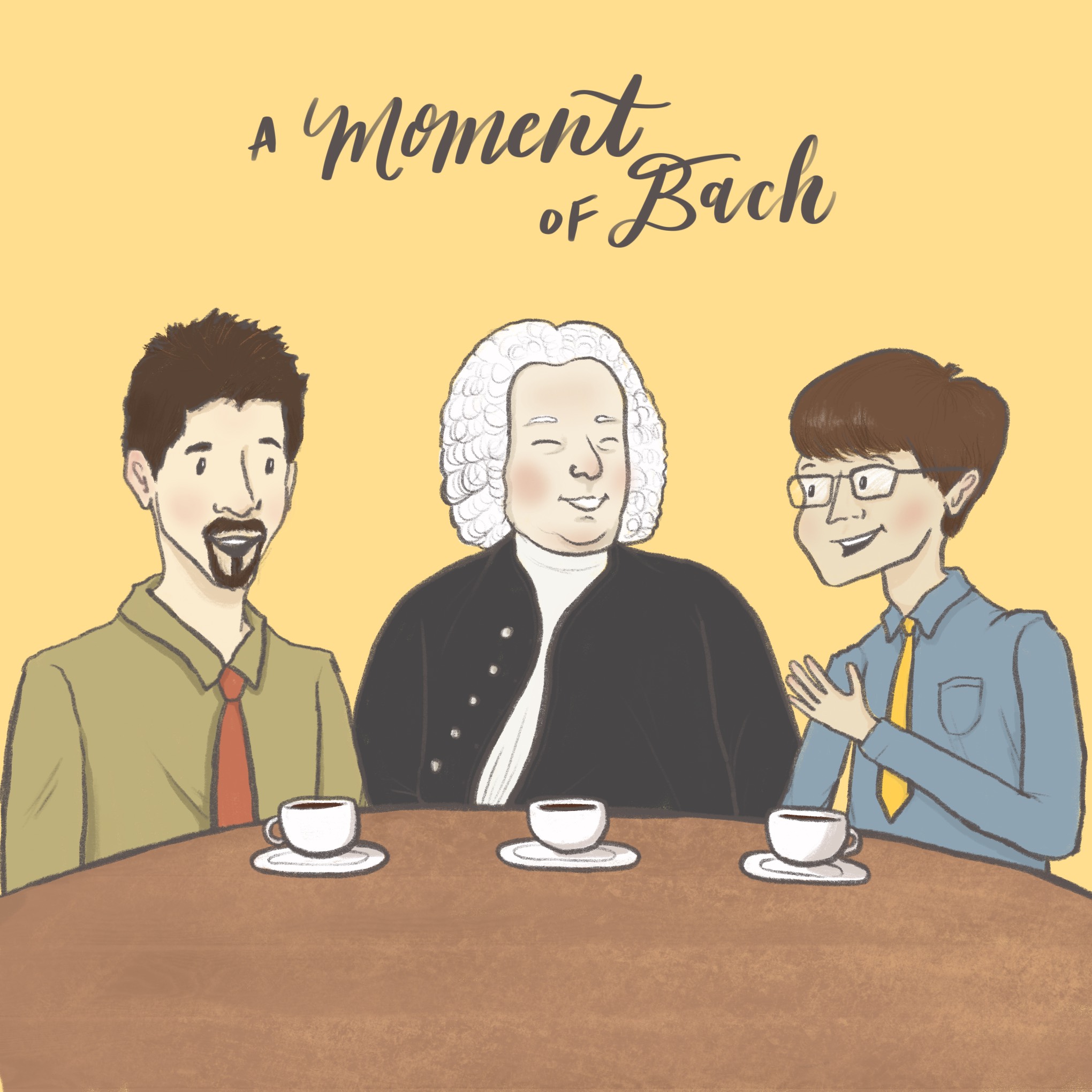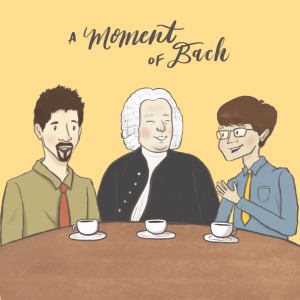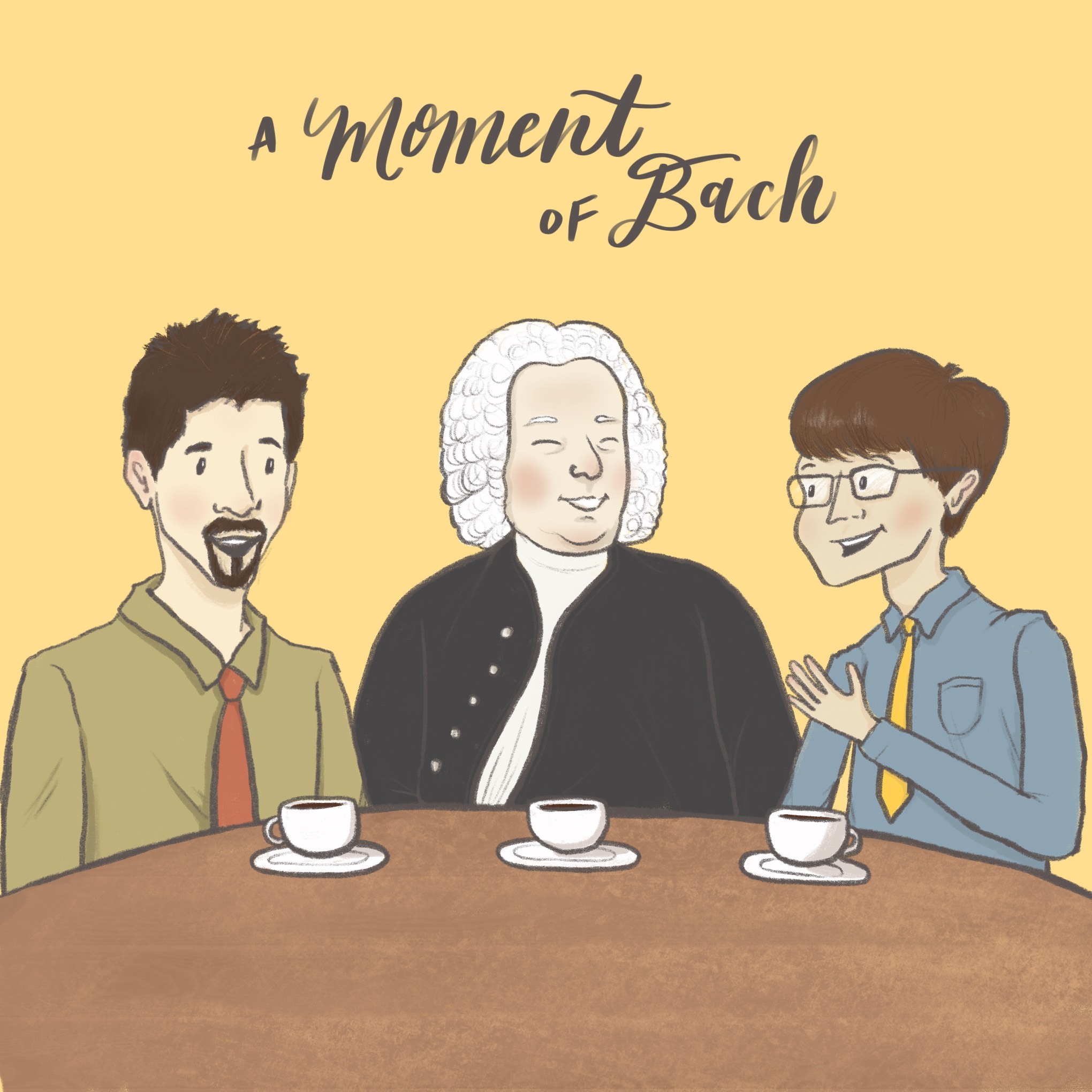
244.4K
Downloads
176
Episodes
Welcome to A Moment of Bach, where we take our favorite moments from J. S Bach's vast output—just a minute's worth or even a few seconds—and show you why we think they are remarkable. Join hosts Alex Guebert and Christian Guebert for weekly moments! Check wherever podcasts are available and subscribe for upcoming episodes. Our recording samples are provided by the Netherlands Bach Society. Their monumental All of Bach project (to perform and record all of the works of J. S. Bach) serves as source material for our episodes. https://www.bachvereniging.nl/en https://www.bachvereniging.nl/en/allofbach Artwork by Sydney LaCom
Episodes

Monday Oct 03, 2022
BACHTOBERFEST season closer and Quodlibet BWV 524
Monday Oct 03, 2022
Monday Oct 03, 2022
Thanks so much to our listeners for being a part of our second season!
On this second BACHTOBERFEST, we answer questions and read some great stories from listeners. We also listen to the hilarious "Quodlibet", a piece that seems too silly for Bach, but it is indeed by the master himself, and gives us a glimpse of his sense of humor. We also try a couple of beers, including a German Hefeweizen shandy.
Listeners -- you've helped spread the word -- last year we were at 10,000 episode downloads; now we are over 55,000. Thank you!!
We'll drop a blooper reel for Season 2 soon, as well as a bonus interview with composer and conductor Jim Meredith.
PATREON -- a new opportunity to donate to A Moment of Bach -- always optional, always appreciated!
Artwork by Syndey LaCom
Musical examples provided by the Netherlands Bach Society

Monday Sep 26, 2022
Concerto in A minor for four harpsichords (BWV 1065)
Monday Sep 26, 2022
Monday Sep 26, 2022
A Moment of Vivaldi! This week, we look at Bach's transcription of Vivaldi's concerto for 4 violins. The crisp and elegant style of Vivaldi gets magnified by Bach here. 4 violins become 4 harpsichords, and the snapping and clicking of the harpsichord strings become a delightful metaphor for the clockwork precision of the composition and the structure of the music. We quote a character from a Douglas Adams novel, who, along with us, sits down to listen to a piece by Vivaldi and marvels that something could be so sublime and yet so mechanical at the same time. Also, listener Will gives us a great moment of violin shredding, and Alex chooses his favorite moment of dissonance from the end of the second movement, where a multiple trill on a diminished chord gives us one of the crunchiest sounds in all of baroque music.
Listeners! Do you have a question you'd like us to answer "on-air" next week on our BACHTOBERFEST season closer episode? Let us know -- ask it directly on our website page.
Performance of BWV 1065 by Netherlands Bach Society
Dirk Gently's Holistic Detective Agency by Douglas Adams (book quoted in this episode)

Monday Sep 19, 2022
Invention in A major (BWV 783)
Monday Sep 19, 2022
Monday Sep 19, 2022
Beloved by pianists, piano teachers, composers, and theory instructors, the Bach Inventions hold a special place in many of our hearts. Why are they called "Inventions" when nothing else is? Why did he include an ornamentation performance guide for them in the "Klavierbüchlein" where he wrote them, when he never did this for anything else in his life?
We take a look at one inventive and energetic moment from Invention no. 12 in A major from the Netherlands Bach Society's series of Inventions performed and recorded by young musicians.
Invention in A Major performed by harpsichordist Peiting Xue
All 15 inventions BWV 772-786: Netherlands Bach Society young performers

Monday Sep 12, 2022
Was Gott tut, das ist wohlgetan (BWV 99)
Monday Sep 12, 2022
Monday Sep 12, 2022
Is this a cantata? Is this a chorale fantasia movement of a cantata? Is this a concerto? What is this thing?
The answer is: all of the above! By now, it shouldn't surprise us that Bach was not satisfied with simplicity. Here, he combined the chorale fantasia and concerto forms together into this unique first movement of a cantata, achieving some delightful contrasts of orchestral color.
Netherlands Bach Society performs BWV 99: https://www.youtube.com/watch?v=TwmQo97zb6I
Netherlands Bach Society performs BWV 100 (mentioned in this episode): https://www.youtube.com/watch?v=0oS4clt71dU
Come see a (free!) performance of BWV 99 conducted by Alex at his home church of St. John's Lutheran Church, Orange, CA on September 18, 2022: https://www.stjohnsorange.org/event/1222155-2022-09-18-bach-cantata-vespers-concert/

Monday Sep 05, 2022
Widerstehe doch der Sünde (BWV 54): opening
Monday Sep 05, 2022
Monday Sep 05, 2022
Gift!! (That is..."poison" in German.) Put up your guard and resist the curse and poison of sinning -- this is the admonition which Bach gives us in this cantata for solo singer, strings, and continuo. The very first chord with its unstable harmony hits us with this force.
We explore how Bach achieves this and other shocking dissonances even a few progressions (retrogressions?) which don't follow harmonic rules. Clearly the heartbeat bass line could be our resistance against sin -- but does the beautiful sequence of rising notes above represent indelicate passion, or the fight against it?
Widerstehe doch der Sünde as performed by the Netherlands Bach Society, sung by alto Maarten Engeltjes and led by Lars Ulrik Mortensen: https://www.youtube.com/watch?v=tBwjv-QJhIk
Companion video interview with the vocalist: https://www.youtube.com/watch?v=WGjJDFP-AyM&t=0s
Companion video interview with the conductor: https://www.youtube.com/watch?v=OQNxeXKRiJg&t=0s

Monday Aug 29, 2022
Mass in B minor: Kyrie eleison (II)
Monday Aug 29, 2022
Monday Aug 29, 2022
We complete our three-part miniseries on the Kyrie section of the Mass in B minor, focusing on the third movement. And three is the number of the day -- everything here seems to have a three-part structure, from the largest sections of music down to the smallest cell. The Rule of Three pervades.
Netherlands Bach Society performs the Mass in B minor (this link takes you directly to the movement we discuss in the episode):
https://youtu.be/3FLbiDrn8IE?t=956
Rule of Three:
https://en.wikipedia.org/wiki/Rule_of_three_(writing)

Monday Aug 22, 2022
Mass in B minor: Christe eleison
Monday Aug 22, 2022
Monday Aug 22, 2022

Monday Aug 15, 2022
Mass in B minor: Kyrie eleison (I)
Monday Aug 15, 2022
Monday Aug 15, 2022
In January 2021, on our very first episode, we explored a "bass drop" moment at the very end of Bach's monumental Mass in B minor, where the soaring high voices and instruments suddenly give way to a deep, full, bass sound, in one of the most satisfying moments of music of all time!
Today, we revisit the evergreen Mass in B minor, and find another "bass drop" moment suggested by listener Bill -- this time from the very first movement. Here, the fugue subject enters for the first time in the bass voices, and in a stroke of genius, the Netherlands Bach Society has the full bass section enter for the first time at this critical moment.
The video by the Netherlands Bach Society is a true artistic treasure -- not to be missed! See it here -- and listen with headphones or good speakers -- enjoy:

Monday Aug 08, 2022
French Suite no. 4 in E-flat major (BWV 815): Allemande
Monday Aug 08, 2022
Monday Aug 08, 2022
"The psychological effect of all this key-shifting, some jerky, some smooth, is very difficult to describe...perhaps it is the magic of Bach that he can write pieces with this kind of structure which have such a natural grace to them that we are not aware of exactly what is happening." In this episode we use these words by author Douglas Hofstadter to explore Bach's harmony as a deep stack of entangled and recursive structures. A moment from listener Santiago is the smallest of these stacked units, and we use it to zoom out.
French Suite no. 4 as played by harpsichordist Pierre Hantaï for the Netherlands Bach Society (the Allemande is first):
https://www.youtube.com/watch?v=J2rQtGtxpOw

Monday Aug 01, 2022
Darzu ist erschienen der Sohn Gottes (BWV 40): opening chorus
Monday Aug 01, 2022
Monday Aug 01, 2022
Today, we give a play-by-play of the opening chorus of this extravagant cantata, which was suggested to us by listener Riley. We talk horns, stretto, and... why you should listen to all different kinds of music.
See this delightful work as performed by the Netherlands Bach Society:
https://www.youtube.com/watch?v=vLDTvI1RrgI
Thanks to all our listeners! And this week, an extra thank-you goes to Riley for suggesting this cantata!
